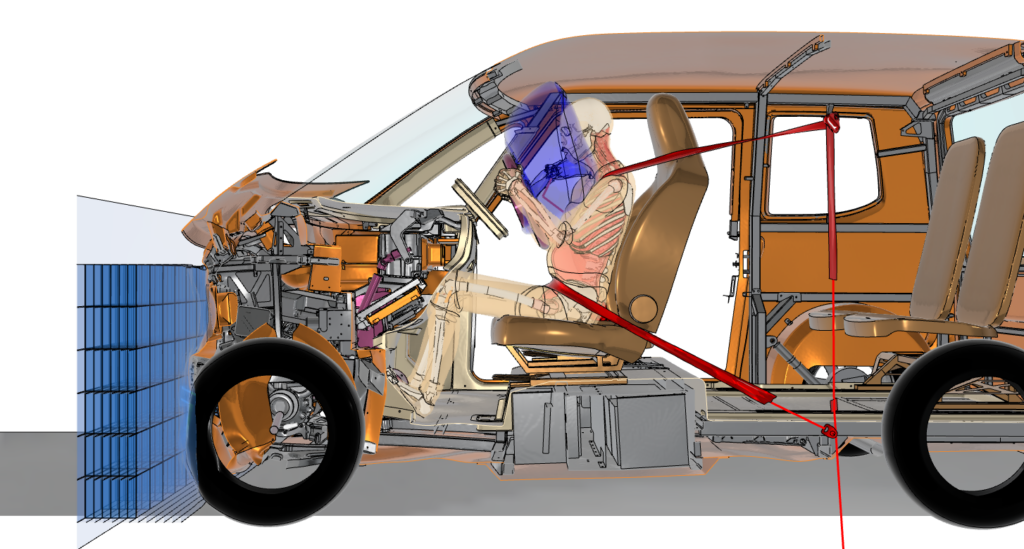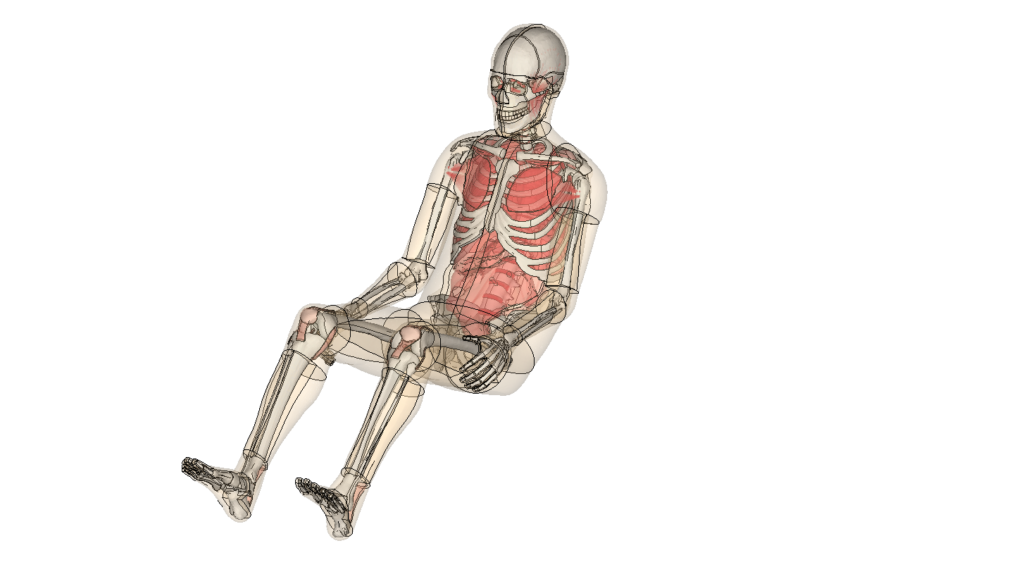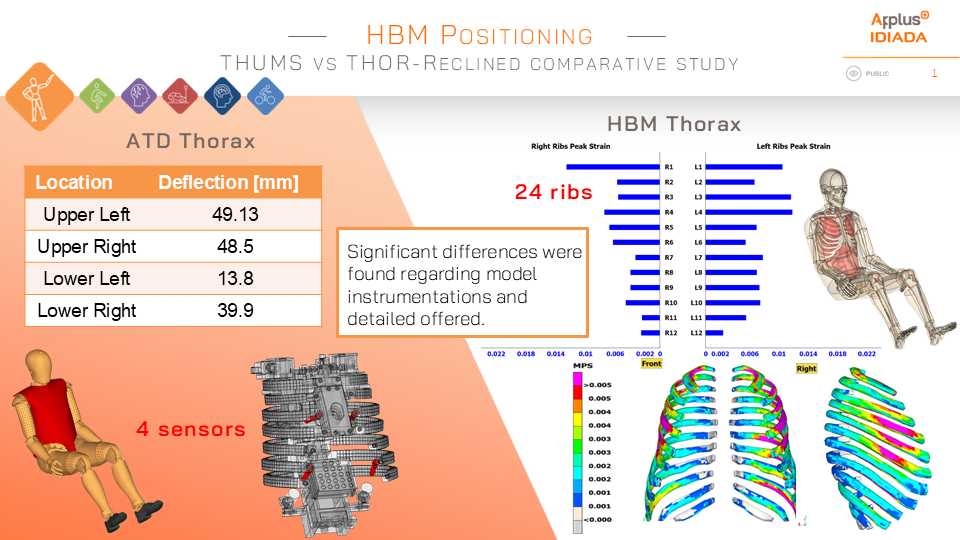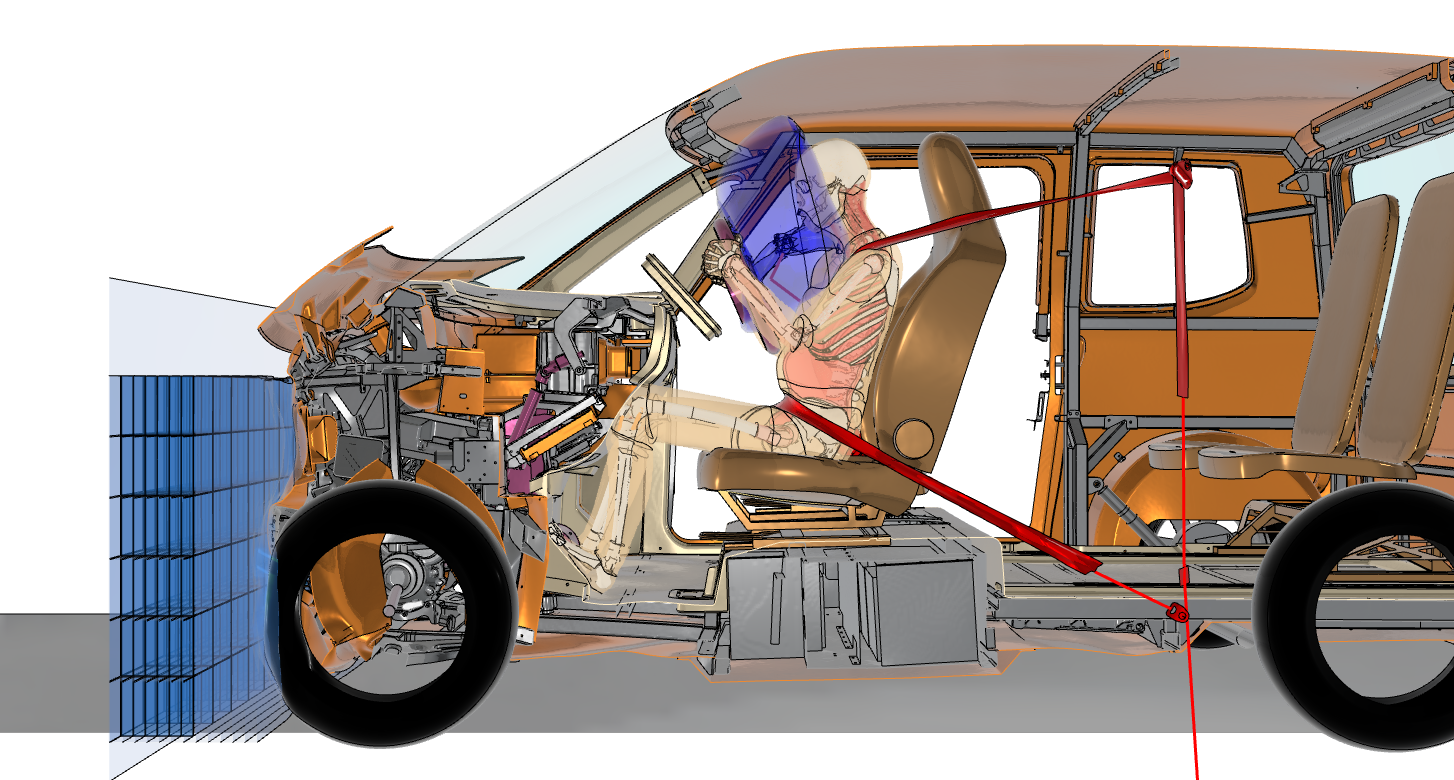Written by:
Human Body Models (HBMs) are advanced digital representations of the human body designed to simulate human responses under various physical stresses. Widely used in vehicle safety research, these models provide detailed insights into injury mechanisms and crash protection. In this article, we’ll dive deeper into how HBMs work, their latest advancements, and their critical role in road safety innovation.
What is a Human Body Model (HBM)?
A Human Body Model (HBM) is a virtual representation of the human body, with which you can measure, e.g. displacements, forces and deformations when external loads are applied. Human Body Models (HBM) for vehicle safety research and development are highly detailed digital replicas of the human body used to gain insight into how road users might get injured in traffic accidents, and based on these results, improve crashworthiness. These computer models include bones, muscles, and even organs, allowing researchers to study injuries in a level of detail that physical dummies do not allow.

Figure 1: Exploring Gender Disparities in Heavy Quadricycle Crash Tests: Assessing Male and Female Human Body Models under Euro NCAP Frontal Impact Protocol. P. Lozano, S. Roka. 2024. EU Project REFLECTIVE (https://www.reflective-h2020.eu/)
Why are Human Body Models important in road safety research?
Human Body Models offer a more detailed and accurate representation of the human responses and injury mechanisms than traditional Anthropomorphic Test Devices (ATDs) – also known as crash test dummies – which are limited in the biomechanical representation of a human body. In addition, HBMs can be morphed to represent the broader anthropometry found in the population. Age can also be incorporated, either in the geometry and material definition, or through the probability of fracture.
For instance, HBMs can predict the likelihood of a fracture in an elderly occupant compared to a younger one, taking into account ageing effects on bone material properties such as increased fragility. HBMs help to pave the way for personalised safety solutions tailored to a broader range of body types.

Figure 2: Example of a Human Body Model, namely THUMS AM50 V6.1. The soft tissues (skin, fat, and muscle) are shown transparent, making the skeleton underneath visible.
How do HBMs compare to crash test dummies?
Crash test dummies are physical and virtual tools that can measure basic forces during impacts, but they lack the complexity of real human anatomy. HBMs go further by having a detailed anatomical representation of the human body. Furthermore, HBMs can predict injuries more accurately than traditional ATDs, such as the probability of a certain rib fracturing under a certain load or how the brain may deform in a collision. For instance, the deformation of each rib can be measured using an HBM, whereas the global deformation of the thorax is measured using four sensors in the case of the THOR dummy, as shown in the figure below.
While dummies are standardised (e.g., representing a small female or an average male), HBMs can be adjusted for height, weight, and age. Also, ATDs are designed for very specific loading scenarios. Each loading condition must be tested with a specific dummy. HBMs, however, offer the possibility of being loaded omnidirectionally. This allows researchers to study multiple scenarios, e.g. oblique collisions, with the same HBM. However, the two tools are complementary. While dummies provide data on a physical test with a car that can be compared with its virtual counterpart, HBMs provide more detailed biomechanical loading information, but only in the virtual world. Furthermore, active HBMs, including muscle reactions, can represent human behaviour during pre-crash manoeuvres, such as braking or lane change, whereas dummies are too stiff to predict occupant kinematics during pre-crash loadings. Together, they provide a more complete picture of crash safety.

Figure 3: Differences in thorax deformation measurements between a crash test dummy and a Human Body Model.
What are the latest advancements in HBM development?
Recent advances in HBM development include improving relevant body regions to assess injuries in new seating postures, such as reclined, integrating active musculature to simulate different muscle states and predict occupant movement during the pre-crash phase (braking or lane-changing manoeuvres) or scaling models to represent diverse populations.
What are the current limitations of HBMs?
The main limitation of HBMs lies in the lack of sufficient validation data. Furthermore, data are also required for the definition of injury metrics. Unlike crash dummies, which are validated through standardised physical tests, HBMs require detailed biological response data from multiple load cases, ideally including diverse populations (e.g., tissue strain rates, different bone materials) that can be challenging to obtain due to ethical and technical constraints.
Their accuracy also depends on the quality of the input data; for example, modelling soft tissues like ligaments and skin remains challenging due to their viscoelastic nature. Another limitation is that in the near future, HBMs will also be used to assess vehicle safety in virtual testing by consumer rating organisations. While injury metrics are standardised for dummies, this is not the case for the assessment of injuries with HBMs.
Moreover, HBMs require immense computational power. These simulations can last up to several days.
What are the key challenges in developing and using HBMs?
Creating HBMs involves balancing scientific precision with practicality. Engineers struggle to replicate the nonlinear behaviour of biological materials. Validating models against real-world data is another hurdle. Accident reconstructions are challenging because many unknowns greatly affect the results of the simulation, such as occupant posture. Therefore, this data is usually not sufficient to validate HBMs, but rather to evaluate their response and gain insight into the causes of injuries. Data to validate HBMs and dummies is normally obtained from Post Mortem Human Subject (PMHS) testing, which are widely available in the literature. However, there is still a lack of data for high-rate deformations, certain body regions, and sometimes the loading conditions are not well enough described to be replicated in simulations. In addition, data from volunteer tests at low g accelerations are used to validate active HBMs for their application in braking or lane-changing manoeuvres.
How will HBMs be improved within the IMPROVA project?
The IMPROVA project aims to improve the use of HBMs to assess the long-term consequences (LTC) of road traffic accidents. The project will focus on injuries to the head, lumbar spine and lower extremities. This includes improving the biofidelity of the models in the lumbar spine and lower extremities regions, based on literature data, and developing a novel metric to assess LTC risk. Finally, a Response Surface Model (RSM) will be developed to speed up the identification of the most critical head impact scenarios in the vehicle cabin.
What are the planned use cases for HBMs in IMPROVA?
One of the main objectives of the IMPROVA project is to enhance road safety for as many road users as possible. Improvements in injury assessment, focusing on LTC, for body regions such as the lower extremities and lumbar spine, are planned for car occupants. The study of lower extremity injuries is also considered for Vulnerable Road Users (VRUs), such as pedestrians. Part of the project is also dedicated to assessing specific injuries sustained by Powered Two-Wheeler (PTW) users. Additionally, the use of Human Body Models (HBMs) is planned to support the development of Personal Protective Equipment (PPE) for e-scooter and bicycle users.
How could HBMs help reduce Long-Term Consequences from road crashes?
HBMs can provide a detailed insight into the load on the different body regions, which in turn can help to identify injury mechanisms and critical factors associated with their cause. A good understanding of these critical factors will enable the further development of safety systems that focus on mitigating not only severe injuries but also minor injuries that may lead to long-term consequences.



